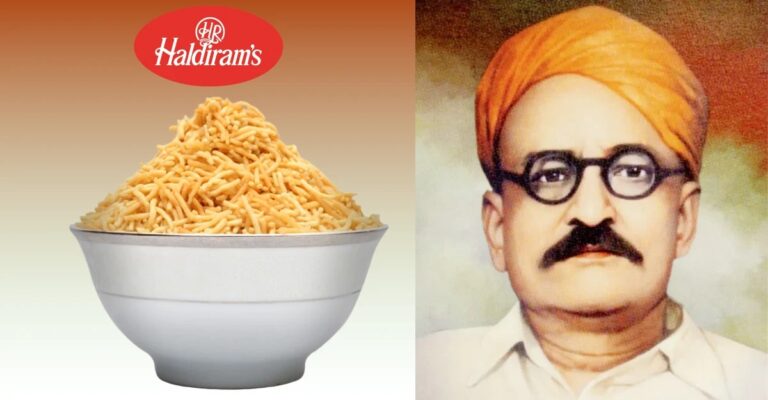Spicing the World: The Incredible Journey of Haldiram's


The story of Haldiram’s is one of resilience, innovation, and strategic brilliance. From a small shop in Bikaner, this brand has transformed into a household name, not just in India but across the globe. This blog explores the fascinating journey of Haldiram’s, the innovative strategies that led to its success, and the lessons that can be learned from its remarkable growth.
The Early Years: A Spark of Inspiration
In 1919, a twelve-year-old boy named Haldiram Agarwal began his journey in the bustling streets of Bikaner. His earliest experiences were shaped by his family’s humble background and their small bhujia shop. Haldiram’s grandfather sold bhujia, and it was here that young Haldiram learned the art of making this popular snack.
Haldiram was not satisfied with just selling bhujia; he had dreams of expanding his family’s business. By noticing the local preference for moth dal over gram flour, he began to innovate his bhujia recipe, leading to the creation of a unique and delicious snack that quickly gained popularity.
Innovation: The Key to Success
Haldiram’s journey is a testament to the power of innovation. Realizing that the existing bhujias were thick and soft, he experimented with different recipes and techniques to create a thinner, crispier version. This innovative approach not only enhanced the taste but also improved the overall eating experience for customers.
Haldiram’s commitment to quality and innovation didn’t stop at the recipe. He understood the importance of branding and positioning. By naming his bhujia “Dungar Sev” after the respected Maharaja Dungar Singh, he elevated its status, making it a premium product in the eyes of consumers. This clever marketing strategy allowed him to charge higher prices, which customers willingly accepted.
Challenges and Resilience
The path to success was not without its challenges. In 1944, personal conflicts led Haldiram to leave his home and his business. Despite this setback, he quickly adapted to his new circumstances. With the help of a childhood friend, he secured some funds and began anew, this time venturing into selling moong dal, another staple in Bikaner.
Haldiram’s perseverance paid off as he re-established his reputation in the market, eventually becoming known as the local bhujia king once again. His ability to bounce back from adversity showcases the importance of resilience in entrepreneurship.
Expansion: From Bikaner to Kolkata
The 1950s marked a significant turning point for Haldiram’s business. After a successful trip to Kolkata for a wedding, where he received overwhelming praise for his bhujia, Haldiram recognized a golden opportunity. In 1955, he sent his son and grandson to set up a shop in Kolkata, where they quickly found success.
By catering to local tastes and introducing products like the Bengali mixture, Haldiram’s expanded its customer base. The Kolkata branch swiftly grew, illustrating the power of adapting to regional preferences in business expansion.
Strategic Growth into Nagpur
In 1968, Haldiram’s grandson, Shivkishan, opened a branch in Nagpur, where he capitalized on the local love for sweets. By offering free samples of new products, such as kaju katli, he quickly gained traction in the market. This strategic move not only established Haldiram’s presence in Nagpur but also marked the beginning of its evolution into a significant player in the Indian sweets market.
Recognizing the potential of the restaurant model, Shivkishan transformed the shop into a restaurant, initially offering popular South Indian dishes. This decision proved successful, as customers began to enjoy the diverse menu, which eventually included Haldiram’s signature snacks.
Facing Adversity Again: The 1984 Riots
Haldiram’s journey faced another major obstacle during the anti-Sikh riots in 1984. Manohar Lal, who was managing the Delhi branch, faced devastating losses when his shop was burned down. However, with the support of his family and a strong reputation, he rebuilt the business and expanded operations, showcasing the brand’s resilience once again.
Embracing Modernization and Packaging Innovations
As the business grew, Haldiram’s recognized the potential of packaged foods in the Indian market. After liberalization in the 1990s, the demand for convenience foods surged. Haldiram’s capitalized on this trend by introducing nitrogen packaging, which extended the shelf life of their products significantly.
This innovation allowed Haldiram’s to distribute its snacks not only within India but also internationally, reaching customers in over 80 countries. The brand diversified its offerings, introducing hundreds of packaged food items that appealed to a wide range of consumers.
Lessons from Haldiram’s Success
The journey of Haldiram’s offers valuable lessons for aspiring entrepreneurs:
- Innovation is Key: Continuously innovate your products to meet customer preferences and enhance their experience.
- Branding Matters: Effective branding and positioning can elevate a product’s status in the market.
- Resilience is Crucial: Overcoming challenges and setbacks is a vital part of any entrepreneurial journey.
- Adapt to Local Tastes: Understanding and catering to regional preferences can significantly boost business expansion.
- Embrace Modern Trends: Keep an eye on market trends and adapt your business model accordingly, especially in packaging and convenience.
Conclusion: A Legacy of Success
Today, Haldiram’s stands as one of the largest snack manufacturers in India, with an annual revenue surpassing ₹9000 crores. Its journey from a small bhujia shop in Bikaner to a global brand is a testament to the power of innovation, hard work, and strategic thinking.
The story of Haldiram’s serves as an inspiration for entrepreneurs everywhere, proving that with dedication and the right approach, even the humblest beginnings can lead to extraordinary success.
